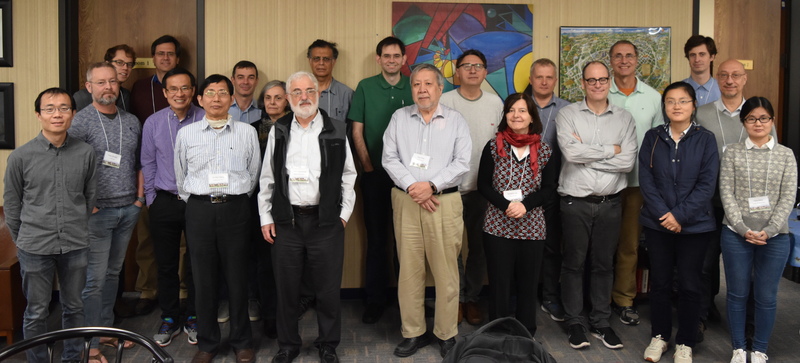Analysis and geometry on pseudohermitian manifolds
November 6 to November 10, 2017
at the
American Institute of Mathematics,
San Jose, California
organized by
Sorin Dragomir,
Howard Jacobowitz,
and Paul Yang
Original Announcement
This workshop will be devoted to mathematical analysis and differential geometry on
pseudohermitian manifolds. The analysis of solutions to the tangential
Cauchy-Riemann equations is best performed in the presence of nondegeneracy
assumptions on the given CR structure. For then a contact form $\theta$ may be chosen
and differential geometric methods become available, for instance to compute CR
invariants (e.g. the Chern-Moser tensor, or Kohn-Rossi cohomology) in terms of
pseudohermtian invariants. An array of differential geometric objects (e.g. a
sub-Riemannian structure along the maximally complex distribution together with
the resulting Carnot-Caratheodory distance function, the Webster metric, the
Tanaka-Webster connection embedding the subRiemannian geometry at hand into
connection theory, the Fefferman metric bringing into the picture methods and
results from Lorentzian geometry) spring naturally from $\theta$ and manifest either as
sources of problems (e.g. the CR Yamabe problem, the existence and partial
regularity problem for subelliptic harmonic maps from a CR manifold) or as
geometric tools (e.g. the description of Cartan chains as projections of null
geodesics of Fefferman's metric).
The workshop will concentrate on the following themes:
- Applying subelliptic theory to pseudohermitian geometry, as prompted by the
occurrence, on any strictly pseudoconvex pseudohermtian manifold $(M,\theta)$,
of the sublaplacian $\Delta_b$ and of the Kohn operator $\Box_b$, and
exploiting the interrelation between hyperbolic and subelliptic theories [as
urged by the presence of the Fefferman metric, a Lorentzian metric on the total
space of the canonical circle bundle over $(M,\theta)$]. In particular one aims for a
version of Kohn-Hodge-de Rham theory on CR Lie groups (endowed with left
invariant pseudohermitian structures).
- Investigating the relationship between pseudohermitian geometry and spacetime
physics, in relation to the occurrence of shear free null geodesic congruences
on certain Lorentzian manifolds (e.g. Fefferman like spacetimes, Godel's
universe) leading to orbit spaces admitting naturally defined strictly
pseudoconvex CR structures. In particular, the CR embedding problem as related
to Einstein's gravitational field equations.
- A new curvature invariant called the $Q$-prime curvature associated to a CR
structure was recently developed together with intrinsic linear operators (the
$P$-prime operators). These are the natural replacement for the $Q$-curvature and
the Paneitz operator for CR geometry. These curvature invariants give rise to
global CR invariants prompting new investigations in relation to global
topological invariants.
The workshop will attempt to gather researchers whose mains scientific
interests are related to one or more of the following areas:
- analysis in several complex variables,
- theory of Hormander systems of vector fields and subelliptic partial
differential equations,
- differential geometry on CR, pseudohermitian, and Lorentzian manifolds.
Material from the workshop
A list of participants.
The workshop schedule.
A report on the workshop activities.
A list of open problems.
Papers arising from the workshop:

